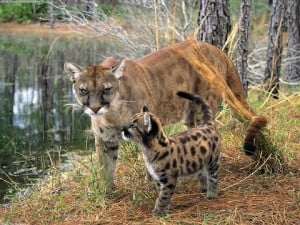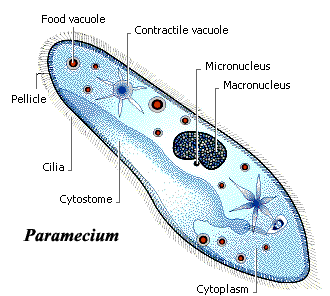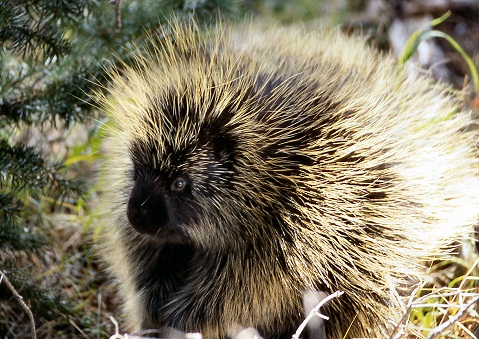In 2011 I wrote about a research project I went on in France to investigate how invertebrates can show the level of water pollution in rivers and streams (click here). While I was there, I quickly picked up on the huge diversity of life in rivers, far beyond what we would expect. While searching through one kick sample, I came across a twig which moved and then a little Caddisfly larva emerged – I was fascinated! 
Animal Features
A Sensory Quest: BBC Wonders of Life

The S in MRS GREN, sensitivity, stands for the ability of all living things to detect changes in their environment. To do this we use our senses, a characteristic dating back to virtually the beginning of life. Even simple, single celled organisms can sense their environment and respond to it.
Florida Panther: When will we learn?
 A new year, means a new calendar, and here in the office I have just got mine – and it is animal themed! I have decided at the start of each month I will write a blog about the featured animal. So, lets start the brand new feature to my blog!
A new year, means a new calendar, and here in the office I have just got mine – and it is animal themed! I have decided at the start of each month I will write a blog about the featured animal. So, lets start the brand new feature to my blog!
The Florida Panther
As you might expect, this panther lives in the forests and swamps of southern Florida, and as is to be even more expected in current times, this animal is endangered.
But! The news for these panthers is actually quite positive!
Porcupines show humans how design is done.
Firstly I apologise to my regular readers for not putting up any posts in the last few weeks (months!). My new job is going well, but as I’m sure you can all understand it has taken priority! But do not fear, I’m back, and I’m going to try my best to get posting regularly again!
 When I moved to Cambridge I had a lot of ‘stuff’ I had accumulated, including two very prickly cacti. One of the thorns from the cacti got caught in my finger and, when I tried to pull it out it snapped, so it was stuck in my finger! Highly inconvenient to me, but it did get me thinking about animal and plant defences, as well as the pain they can cause!
When I moved to Cambridge I had a lot of ‘stuff’ I had accumulated, including two very prickly cacti. One of the thorns from the cacti got caught in my finger and, when I tried to pull it out it snapped, so it was stuck in my finger! Highly inconvenient to me, but it did get me thinking about animal and plant defences, as well as the pain they can cause!
Do you really know what’s lurking in the depths? Meet Peter’s elephantnose fish.
It has been my intention to write a post telling you all about my new pets – I have recently bought and set up a tropical aquarium. I have wanted to have fish since I can remember and even insisted on having an ‘under the sea’ themed bedroom for many years! Anyway a couple of months ago I decided to take the leap! Picking which fish to have was not easy, but I now have a small community of fish that I am more than happy with! I like my fish to have something interesting about them, a bit of history if you like. This might be where they came from, a novel feature they have, or perhaps just a great personality (I may or may not have imagined!).
Albinism: Another excuse to collect the rare and exotic?
Across the entire animal kingdom there are some fascinating, sometimes even unbelievable characteristics. The adaptations that have made it through natural selection, been accepted by females and after all that aren’t a disadvantage, are truly exquisite. How do these adaptations come about? Random genetic mutations are at the beginning of every single adaptation on this planet. It is these mutations within the gene that are responsible for colouration, size, shape and many more! Sometimes mutations can result in something which is not advantageous – a mutational disorder. The disorder I wanted to discuss today is albinism.
How did the Zebra get its stripes?
For centuries we have asked questions of evolution. Questions such as why does a Leopard have spots, how did a Camel get it’s hump or perhaps most famous of all: why is a Giraffe’s neck so long? A lot of the time people create “just-so” stories to answer these questions. For example, “it was favourable in terms of evolution by natural selection to be a Giraffe with a longer neck to reach higher branches”. When this theory was tested they found that Giraffes actually spend most their time foraging in low branches. Scientists now believe the long necks are used by males to fight each other for access to females to mate with. (The fact they can also reach higher into fruit bearing trees is an added bonus!) This is called necking. There are plenty of videos on YouTube if you are interested! Most just so stories have now been tested and more scientifically minded and testable hypotheses have been given to describe them. However there is one story that has been puzzling scientists until now: why does a Zebra have its stripes?
Lost Animals from 505 million years ago – A fun Christmas read!
Lost Animals from 505 million years ago
It’s Christmas Eve and I can’t bring myself to write a serious post so instead I am bringing to you a feature on some of my favourite animals from the Cambrian – a period of time 542 million years ago.
Orangutan real-estate provides new hope.
 Spending time with a particular animal undoubtedly creates a bond that stays with you for a long time, if not for life. In my life, this has been the case for my horses, dogs, the elephants I looked after at the zoo, as well as a certain cheeky tapir that liked to have his tummy tickled. Another animal I became particularly attached to was the Orangutan.
Spending time with a particular animal undoubtedly creates a bond that stays with you for a long time, if not for life. In my life, this has been the case for my horses, dogs, the elephants I looked after at the zoo, as well as a certain cheeky tapir that liked to have his tummy tickled. Another animal I became particularly attached to was the Orangutan.
Communication in the depths: perhaps not as primitive as we would like to think – Coleoid communication.
Have you ever wondered how animals communicate? Some animals have incredibly complex behaviour, and in many cases communication is a vital part of that behaviour. I have recently been researching communication in Coleoids and I wanted to demonstrate to you all how complex, and beautiful in its complexity this communication is.


